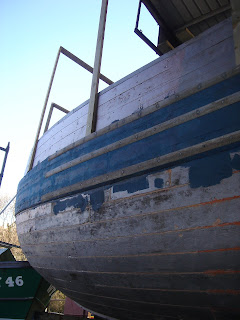Hibble, Bibble, Toil and Gribble
 Since the new year the hull has many planks and bits of planks replaced including where there was a "skin fitting" (a kind of tap in the hull to let water in, or other liquids out, such as bilgewater) now we have a water-tight boat, and a kind of blank canvas to start making holes for new skin-fittings, which will be fewer and much more easy to get at
Since the new year the hull has many planks and bits of planks replaced including where there was a "skin fitting" (a kind of tap in the hull to let water in, or other liquids out, such as bilgewater) now we have a water-tight boat, and a kind of blank canvas to start making holes for new skin-fittings, which will be fewer and much more easy to get atSo every part of the hull that had a hole in it is now sorted, including places where Ship’s worms had a feast. The worst damage by these little crustaceans was to the planks were behind the keel-cooler. which was never moved for nearly 40 years and the hardest place to put antifoul – good thing we did to take the cooler off and see, and then could replace the planks where they were more like Crunchie than larch.
For more reading and how gribble destroyed another MFV ...
For more about Crunchie... Crunchie
I read that gribble are now being recruited to help generate bio-fuels from wood, I wonder if I could have sold our infested timber on Ebay...
 Following our exploration of a bay in Ireland, on the way to Eyemouth, without the chart, and ignoring the depth-sounder alarm, we have invested in a new keel shoe; a huge piece of steel to help avoid damaging the oak keel if we “take the ground” ever (again.). More like if the ground takes us...
Following our exploration of a bay in Ireland, on the way to Eyemouth, without the chart, and ignoring the depth-sounder alarm, we have invested in a new keel shoe; a huge piece of steel to help avoid damaging the oak keel if we “take the ground” ever (again.). More like if the ground takes us...The renovated copper keel-cooler is in position and sealed into the hull with lovely sticky tar stuff... This will allow cooling water from the main engine to flow round and lose heat in the sea, rather clever because there is no need for anything more clever, as it were.
 There is now extra strengthening around the "starn", the rudder mountings and where there was a bit more gribble, and up at the front an all-new steel stem covering, galvanised above the waterline. Interestingly not galvanised below, because steel won’t rust below the waterline, so it would be an adverse thing - the zinc would just bubble off like a sacrificial anode, waste of money and effort.
There is now extra strengthening around the "starn", the rudder mountings and where there was a bit more gribble, and up at the front an all-new steel stem covering, galvanised above the waterline. Interestingly not galvanised below, because steel won’t rust below the waterline, so it would be an adverse thing - the zinc would just bubble off like a sacrificial anode, waste of money and effort.
 There is now extra strengthening around the "starn", the rudder mountings and where there was a bit more gribble, and up at the front an all-new steel stem covering, galvanised above the waterline. Interestingly not galvanised below, because steel won’t rust below the waterline, so it would be an adverse thing - the zinc would just bubble off like a sacrificial anode, waste of money and effort.
There is now extra strengthening around the "starn", the rudder mountings and where there was a bit more gribble, and up at the front an all-new steel stem covering, galvanised above the waterline. Interestingly not galvanised below, because steel won’t rust below the waterline, so it would be an adverse thing - the zinc would just bubble off like a sacrificial anode, waste of money and effort. The stem cover was put on after the anti-fouling, fitted and then welded on, and it will be handy in case we run over any semi-submerged shipping containers.

Coping irons are nearly complete down both sides, they will be painted over and they help in small nudgings of other boats, or docks, rocks etc. , so saving the wood. Like mini metal fenders, or bumpers.



0 Comments:
Post a Comment
<< Home